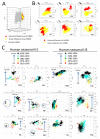Codon usage bias and the evolution of influenza A viruses. Codon Usage Biases of Influenza Virus
- PMID: 20723216
- PMCID: PMC2933640
- DOI: 10.1186/1471-2148-10-253
Codon usage bias and the evolution of influenza A viruses. Codon Usage Biases of Influenza Virus
Abstract
Background: The influenza A virus is an important infectious cause of morbidity and mortality in humans and was responsible for 3 pandemics in the 20th century. As the replication of the influenza virus is based on its host's machinery, codon usage of its viral genes might be subject to host selection pressures, especially after interspecies transmission. A better understanding of viral evolution and host adaptive responses might help control this disease.
Results: Relative Synonymous Codon Usage (RSCU) values of the genes from segment 1 to segment 6 of avian and human influenza viruses, including pandemic H1N1, were studied via Correspondence Analysis (CA). The codon usage patterns of seasonal human influenza viruses were distinct among their subtypes and different from those of avian viruses. Newly isolated viruses could be added to the CA results, creating a tool to investigate the host origin and evolution of viral genes. It was found that the 1918 pandemic H1N1 virus contained genes with mammalian-like viral codon usage patterns, indicating that the introduction of this virus to humans was not through in toto transfer of an avian influenza virus.Many human viral genes had directional changes in codon usage over time of viral isolation, indicating the effect of host selection pressures. These changes reduced the overall GC content and the usage of G at the third codon position in the viral genome. Limited evidence of translational selection pressure was found in a few viral genes.
Conclusions: Codon usage patterns from CA allowed identification of host origin and evolutionary trends in influenza viruses, providing an alternative method and a tool to understand the evolution of influenza viruses. Human influenza viruses are subject to selection pressure on codon usage which might assist in understanding the characteristics of newly emerging viruses.
Figures





Similar articles
-
Genomic analysis of influenza A viruses, including avian flu (H5N1) strains.Eur J Epidemiol. 2006;21(7):511-9. doi: 10.1007/s10654-006-9031-z. Epub 2006 Jul 21. Eur J Epidemiol. 2006. PMID: 16858618 Free PMC article.
-
Analysis of synonymous codon usage in H5N1 virus and other influenza A viruses.Biosystems. 2005 Jul;81(1):77-86. doi: 10.1016/j.biosystems.2005.03.002. Epub 2005 Apr 7. Biosystems. 2005. PMID: 15917130
-
Human genes with codon usage bias similar to that of the nonstructural protein 1 gene of influenza A viruses are conjointly involved in the infectious pathogenesis of influenza A viruses.Genetica. 2022 Apr;150(2):97-115. doi: 10.1007/s10709-022-00155-9. Epub 2022 Apr 8. Genetica. 2022. PMID: 35396627 Free PMC article.
-
[Swine influenza virus: evolution mechanism and epidemic characterization--a review].Wei Sheng Wu Xue Bao. 2009 Sep;49(9):1138-45. Wei Sheng Wu Xue Bao. 2009. PMID: 20030049 Review. Chinese.
-
Recent zoonoses caused by influenza A viruses.Rev Sci Tech. 2000 Apr;19(1):197-225. doi: 10.20506/rst.19.1.1220. Rev Sci Tech. 2000. PMID: 11189716 Review.
Cited by
-
Chloroplast Genomes of Vitis flexuosa and Vitis amurensis: Molecular Structure, Phylogenetic, and Comparative Analyses for Wild Plant Conservation.Genes (Basel). 2024 Jun 10;15(6):761. doi: 10.3390/genes15060761. Genes (Basel). 2024. PMID: 38927697 Free PMC article.
-
Revelation of Influencing Factors in Overall Codon Usage Bias of Equine Influenza Viruses.PLoS One. 2016 Apr 27;11(4):e0154376. doi: 10.1371/journal.pone.0154376. eCollection 2016. PLoS One. 2016. PMID: 27119730 Free PMC article.
-
Analysis of evolutionary and genetic patterns in structural genes of primate lentiviruses.Genes Genomics. 2022 Jul;44(7):773-791. doi: 10.1007/s13258-022-01257-6. Epub 2022 May 5. Genes Genomics. 2022. PMID: 35511321 Free PMC article.
-
Identification and characterization of codon usage pattern and influencing factors in HFRS-causing hantaviruses.Front Immunol. 2023 Jul 10;14:1131647. doi: 10.3389/fimmu.2023.1131647. eCollection 2023. Front Immunol. 2023. PMID: 37492567 Free PMC article.
-
Evidence of selection pressures of neuraminidase gene (NA) of influenza A virus subtype H5N1 on different hosts in Guangxi Province of China.Saudi J Biol Sci. 2014 Apr;21(2):179-83. doi: 10.1016/j.sjbs.2013.09.009. Epub 2013 Oct 2. Saudi J Biol Sci. 2014. PMID: 24600312 Free PMC article.
References
Publication types
MeSH terms
Substances
LinkOut - more resources
Full Text Sources
Other Literature Sources
Research Materials
Miscellaneous

